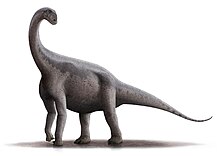Jobaria
| Jobaria Temporal range: Middle Jurassic,
| |
|---|---|

| |
| Mounted cast of a skeleton at the Australian Museum, Sydney | |
| Scientific classification | |
| Kingdom: | |
| Phylum: | |
| Superorder: | |
| Order: | |
| Suborder: | |
| Infraorder: | |
| (unranked): | |
| Genus: | Jobaria
|
| Species: | J. tiguidensis
|
| Binomial name | |
| Jobaria tiguidensis Sereno et al., 1999
| |
Jobaria was a sauropod dinosaur discovered in the Sahara Desert in 1997. It was named after "Jobar", a creature of local legends, and is thought to have been about 18 metres long. It was found in the Tiourarén Formation, originally thought to represent the Hauterivian to Barremian stages of the early Cretaceous Period, or approximately 136 to 125 million years ago (Sereno et al. 1994). However, re-interpretation of the sediments showed that they are probably mid-Jurassic in age, dating Jobaria to the Bathonian to Oxfordian stages, between 164 and 161 mya.[1]
Jobaria seems to be a very primitive sauropod. It has been interpreted either as a basal macronarian (Upchurch et al., 2004), or as a non-neosauropod eusauropod, basal to the neosauropod clade.
The backbone and tail of Jobaria are simple compared to the complex vertebrae and whiplash tail of the later North America sauropods Diplodocus and Apatosaurus.
Posture


Paul Sereno concluded, after comparing the ratios of humerus and femur circumferences in Jobaria to extant elephants, that Jobaria may have been able to rear up on its hind legs.[2] As the weight distribution of Jobaria indicates that it was supported by the rear limbs rather than the forelimbs (as in elephants), it has been speculated that as elephants can rear up, then Jobaria would have been able to more easily.
Bibliography
- Sereno, P.C., Beck, A.L., Dutheil, D.B., Larsson, H.C.E., Lyon, G.H., Moussa, B., Sadleir, R.W., Sidor, C.A., Varricchio, D.J., Wilson, G. P. & Wilson, J.A., (1999), Cretaceous Sauropods from the Sahara and the Uneven Rate of Skeletal Evolution Among Dinosaurs, Science 286(5443): 1342-1347 (Nov 12 1999)
- Upchurch, P., Barrett, P.M., and Dodson, P. 2004. Sauropoda. In The Dinosauria, 2nd edition. D. Weishampel, P. Dodson, and H. Osmólska (eds.). University of California Press, Berkeley.
- Fantastic Facts About Dinosaurs (ISBN 0-7525-3166-2)
References
- ^ Rauhut and Lopez-Arbarello (2009). "Considerations on the age of the Tiouaren Formation (Iullemmeden Basin, Niger, Africa): Implications for Gondwanan Mesozoic terrestrial vertebrate faunas." Palaeogeography, Palaeoclimatology, Palaeoecology, 271: 259-267.
- ^ Could Sauropods Rear?
